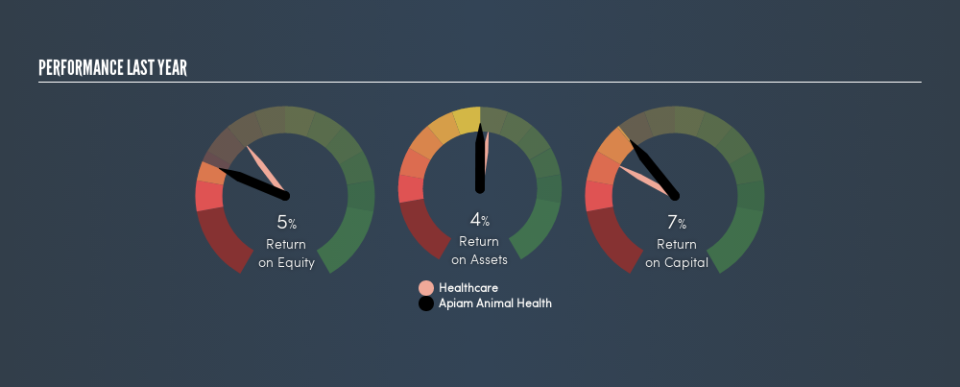Why We’re Not Impressed By Apiam Animal Health Limited’s (ASX:AHX) 7.4% ROCE

Today we'll look at Apiam Animal Health Limited (ASX:AHX) and reflect on its potential as an investment. Specifically, we'll consider its Return On Capital Employed (ROCE), since that will give us an insight into how efficiently the business can generate profits from the capital it requires.
First, we'll go over how we calculate ROCE. Then we'll compare its ROCE to similar companies. Then we'll determine how its current liabilities are affecting its ROCE.
What is Return On Capital Employed (ROCE)?
ROCE is a measure of a company's yearly pre-tax profit (its return), relative to the capital employed in the business. Generally speaking a higher ROCE is better. In brief, it is a useful tool, but it is not without drawbacks. Renowned investment researcher Michael Mauboussin has suggested that a high ROCE can indicate that 'one dollar invested in the company generates value of more than one dollar'.
So, How Do We Calculate ROCE?
Analysts use this formula to calculate return on capital employed:
Return on Capital Employed = Earnings Before Interest and Tax (EBIT) ÷ (Total Assets - Current Liabilities)
Or for Apiam Animal Health:
0.074 = AU$6.3m ÷ (AU$107m - AU$22m) (Based on the trailing twelve months to December 2018.)
So, Apiam Animal Health has an ROCE of 7.4%.
View our latest analysis for Apiam Animal Health
Is Apiam Animal Health's ROCE Good?
When making comparisons between similar businesses, investors may find ROCE useful. We can see Apiam Animal Health's ROCE is meaningfully below the Healthcare industry average of 9.4%. This performance could be negative if sustained, as it suggests the business may underperform its industry. Aside from the industry comparison, Apiam Animal Health's ROCE is mediocre in absolute terms, considering the risk of investing in stocks versus the safety of a bank account. It is possible that there are more rewarding investments out there.
Our data shows that Apiam Animal Health currently has an ROCE of 7.4%, compared to its ROCE of 4.6% 3 years ago. This makes us wonder if the company is improving. You can click on the image below to see (in greater detail) how Apiam Animal Health's past growth compares to other companies.
When considering ROCE, bear in mind that it reflects the past and does not necessarily predict the future. Companies in cyclical industries can be difficult to understand using ROCE, as returns typically look high during boom times, and low during busts. This is because ROCE only looks at one year, instead of considering returns across a whole cycle. Since the future is so important for investors, you should check out our free report on analyst forecasts for Apiam Animal Health.
How Apiam Animal Health's Current Liabilities Impact Its ROCE
Liabilities, such as supplier bills and bank overdrafts, are referred to as current liabilities if they need to be paid within 12 months. The ROCE equation subtracts current liabilities from capital employed, so a company with a lot of current liabilities appears to have less capital employed, and a higher ROCE than otherwise. To check the impact of this, we calculate if a company has high current liabilities relative to its total assets.
Apiam Animal Health has total assets of AU$107m and current liabilities of AU$22m. Therefore its current liabilities are equivalent to approximately 21% of its total assets. It is good to see a restrained amount of current liabilities, as this limits the effect on ROCE.
What We Can Learn From Apiam Animal Health's ROCE
If Apiam Animal Health continues to earn an uninspiring ROCE, there may be better places to invest. Of course, you might also be able to find a better stock than Apiam Animal Health. So you may wish to see this free collection of other companies that have grown earnings strongly.
If you are like me, then you will not want to miss this free list of growing companies that insiders are buying.
We aim to bring you long-term focused research analysis driven by fundamental data. Note that our analysis may not factor in the latest price-sensitive company announcements or qualitative material.
If you spot an error that warrants correction, please contact the editor at editorial-team@simplywallst.com. This article by Simply Wall St is general in nature. It does not constitute a recommendation to buy or sell any stock, and does not take account of your objectives, or your financial situation. Simply Wall St has no position in the stocks mentioned. Thank you for reading.

